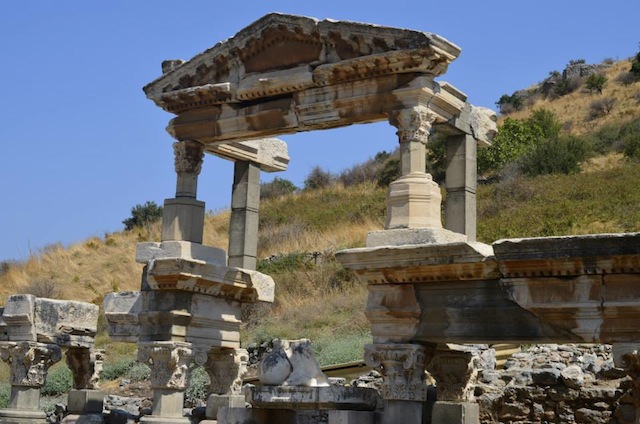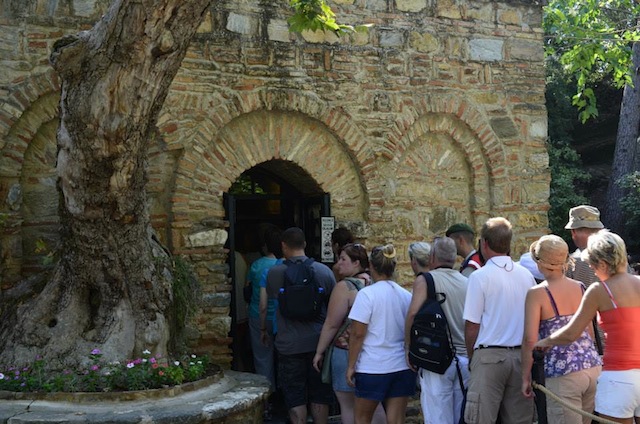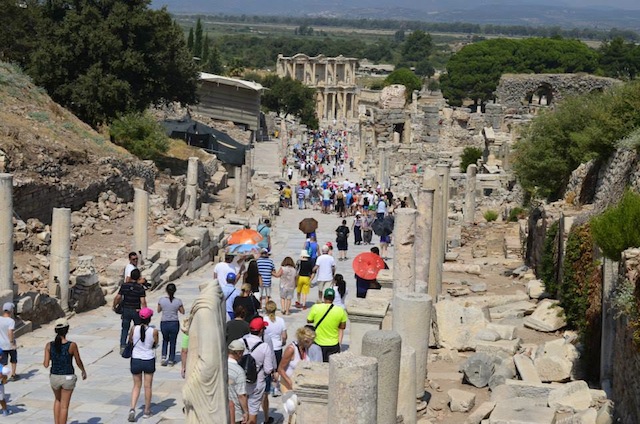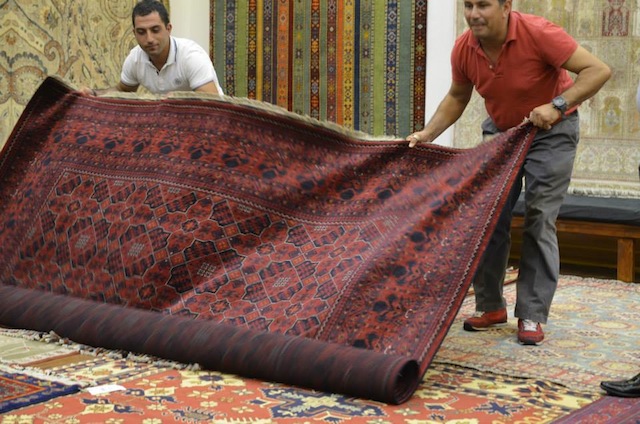
Ruins at Ephesus in Turkey (above). Because of Turkey’s location and history of playing home to many ancient civilizations, it’s known as part of the Cradle of Culture. While Istanbul is full of ancient attractions — for example, the Hagia Sophia, Topkapı Palace, The Basilica Cistern and Rumeli Fortress — it only paints part of the picture. To further explore Turkey’s rich history, you’ll need to explore other parts of the country, for example, Ephesus.
On a recent Holland America “Ancient Mysteries” cruise one of the port stops was Kusadasi, Turkey, an easy day trip from Ephesus with history littered along the route. Unless you just plan on shopping and dining around the harbor, a tour is necessary for getting to Ephesus, for example, a Kusadasi Shore Excursion: Ephesus Sightseeing Tour, which is what I booked.
My guide was a woman named Zeynep. We began the excursion with a brief tour around Kusadasi, before making our way through the Turkish countryside of Selçuk and getting a history and geography lesson on the country.
Turkey is bordered by eight countries — including Bulgaria, Greece, Armenia, Azerbaijan, Georgia, Syria, Iraq and Iran — with the Black Sea to the north, the Aegean Sea in the west and Mediterranean Sea to the southwest. The country lies at the crossroads of Europe and Asia, separated by the Bosphorus Strait, Sea of Marmara and Dardanelles.
Inhabited since the Paleolithic Era, Turkey played home to many ancient civilizations like the Ottoman, Greek, Roman, Byzantine — until it became a secular democracy as the modern Republic of Turkey in 1923 with Atatürk as its first president.

People waiting in line to get into the Virgin Mary’s house. No pictures were allowed to be taken inside.
On the Ephesus Sightseeing Tour the group was given a glimpse into the area’s biblical history at our first stop, the House of the Virgin Mary. A small two-room house where Mary — the Mother of Jesus for the Christians and Mother of Isa for Muslims — spent her final years, it’s an important pilgrimage for Christians and Muslims. While it’s not certain that Mary is buried here, it is said she spent her final years living here. Although there are skeptics, many believe Saint John took Mary here and it’s where she resided until her Assumption or Dormition, depending on your religion.

Walking down Marble Road toward downtown Ephesus.
Afterward we headed to the main attraction of the tour: Ephesus. Ephesus — which is only 18% excavated — was once a harbor with a city constructed near the port, which made it an important commercial center with merchants and traders. Originally a Greek city and later a Roman city, Ephesus’ population was over 250,000 in the 1st century BC. The original inhabitants of Ephesus worshipped Greek Gods — their most important god being Artemis — with the Temple of Artemis being the central focus of the ancient city. Sadly, the temple, once considered one of the Seven Wonders of the Ancient World, was destroyed and rebuilt three times before its complete destruction in 401, aside for one single column that still remains today.

Celsius Library ruins at Ephesus.
The guided tour of the archeology site began at the upper part of Ephesus — the meeting place of the higher class of society — going toward the “downtown” or lower part of Ephesus. While there is much to see along the way, there were some highlights that truly stuck out. For example, the men’s latrines consisted of long wooden benches with side-by-side holes for doing your business.
It was like a social gathering place where men would hangout and catch up while going to the bathroom. There’s also the Hillside Terrace Houses, which provide a glimpse into the life of Ephesus’ elite with their mosaic tiled floors and ancient villa-style architecture. Another highlight is the open-air Commercial Agora, where over 100 shops resided in an open-air plaza selling goods and slaves.
And of course, the Celsius Library — once the third largest library in the world, home to over 12,000 scrolls — is possibly the most beautifully restored attraction in Ephesus. These are just a few of the many points of interest in Ephesus, with some others including the Temple of Hadrian, Gate of Hercules and the Trajan Fountain.

Local Turkish food
Next, the group explored Turkish culture through the tongue by sampling an array of local dishes at a restaurant called Turkmen. To start, we were served a creamy, tangy tzatziki; fresh local olives; salad made with local produce; Turkish pastries rolled like cigars and filled with cheese; a plate of fried potatoes topped with eggplant and tomato; and fluffy bread rolls. The main course was grilled chicken skewers, kofte and Turkish rice, which I paired with a refreshing glass of local white wine. The experience finished with sweet local melon.

Women making carpets by hand in at Turkmen.
As Turkmen is part of Turkmen Carpet, a demonstration on how the carpets are crafted was also part of the experience. Carpets have been around for at least 4,000 years, meaning they tell the story of humanity from past to present and future. The process begins with the beating of silk cocoons with a brush in hot water. Gather the silk away from the brush and it will unravel so you can thread it into a giant wooden wheel. Once you’ve threaded a bunch of the silk cocoons into the wheel you can spin it quickly, allowing all of them to unravel. The water appears as if it’s boiling as the cocoons bounce quickly up and down.

Carpet making demonstration at Turkmen.
From there, we saw the women actually hand-weaving the patterns. In Turkey they use a double looping knot (Turkish or Ghiordes Knot) technique that’s only used on Turkish carpets. These women create both simple and intricate patterns with these knots and all-natural dyes.
An interesting experience comes when the group is instructed to remove their shoes and socks and walk over the different wool and silk carpets to feel the differences with their bare feet. It’s like going to a spa as immediate relaxation washed over you. Interestingly, you can actually see how the patterns change color depending on where you’re standing, as all hand-made carpets feature piles that sit at 45 degree angles so one side absorbs light and one reflects it. Additionally, the oil in the wool gives it a shiny appearance.

Jessica Festa is the editor of the travel sites Jessie on a Journey (http://jessieonajourney.com) and Epicure & Culture (http://epicureandculture.com). Along with blogging at We Blog The World, her byline has appeared in publications like Huffington Post, Gadling, Fodor’s, Travel + Escape, Matador, Viator, The Culture-Ist and many others. After getting her BA/MA in Communication from the State University of New York at Albany, she realized she wasn’t really to stop backpacking and made travel her full time job. Some of her most memorable experiences include studying abroad in Sydney, teaching English in Thailand, doing orphanage work in Ghana, hiking her way through South America and traveling solo through Europe. She has a passion for backpacking, adventure, hiking, wine and getting off the beaten path.








